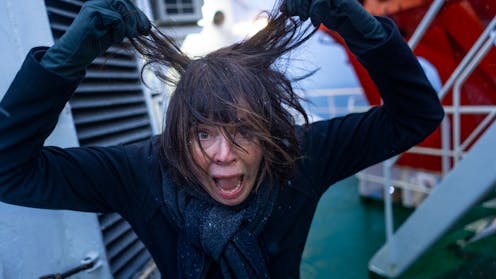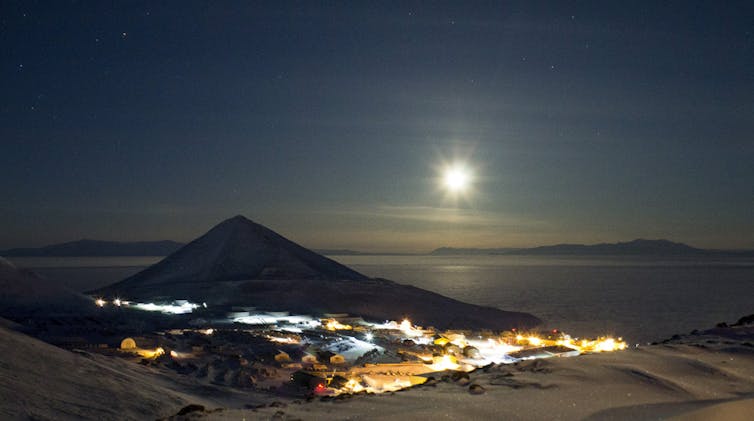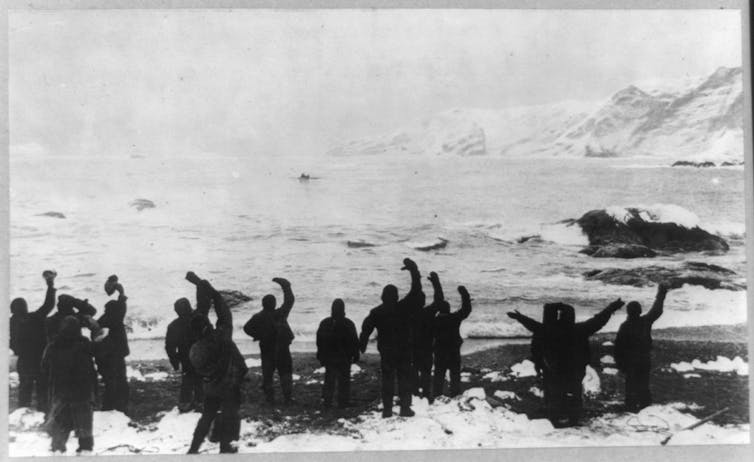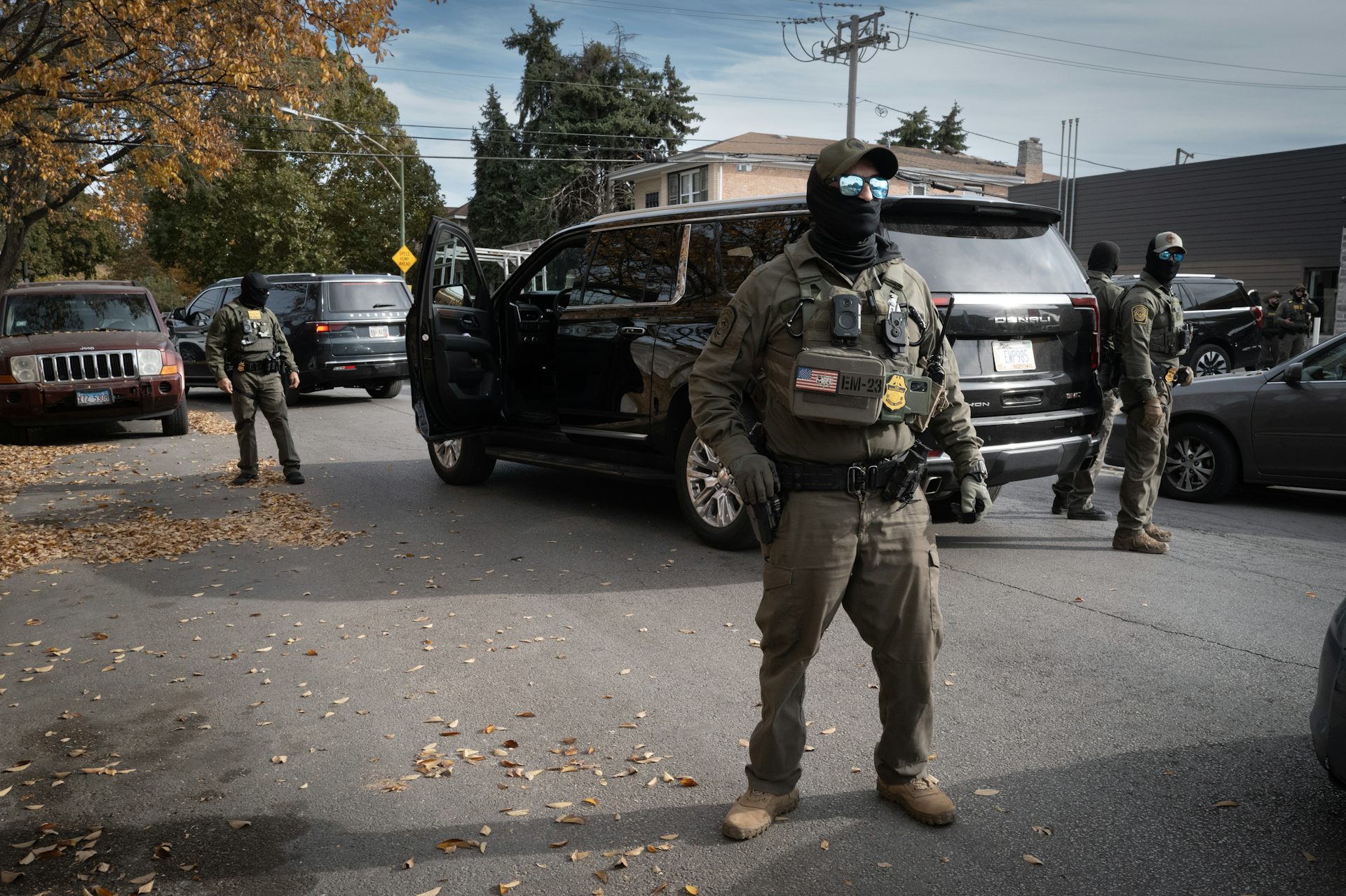At Antarctica’s midwinter, a look back at the frozen continent’s long history of dark behavior
Antarctica is a harsh continent, which in both history and fiction can trigger disturbing behavior and even madness.

As Midwinter Day approaches in Antarctica – the longest and darkest day of the year – those spending the winter on the frozen continent will follow a tradition dating back more than a century to the earliest days of Antarctic exploration: They will celebrate having made it through the growing darkness and into a time when they know the Sun is on its way back.
The experience of spending a winter in Antarctica can be harrowing, even when living with modern conveniences such as hot running water and heated buildings. At the beginning of the current winter season, in March 2025, global news outlets reported that workers at the South African research station, SANAE IV, were “rocked” when one worker allegedly threatened and assaulted other members of the station’s nine-person winter crew. Psychologists intervened – remotely – and order was apparently restored.
The desolate and isolated environment of Antarctica can be hard on its inhabitants. As a historian of Antarctica, the events at SANAE IV represent a continuation of perceptions – and realities – that Antarctic environments can trigger deeply disturbing behavior and even drive people to madness.

Early views
The very earliest examples of Antarctic literature depict the continent affecting both mind and body. In 1797, for instance, more than two decades before the continent was first sighted by Europeans, the English poet Samuel Taylor Coleridge wrote “The Rime of the Ancient Mariner.” It tells a tale of a ship blown by storms into an endless maze of Antarctic ice, which they escape by following an albatross. For unexplained reasons, one man killed the albatross and faced a lifetime’s torment for doing so.
In 1838, Edgar Allan Poe published the story of “Arthur Gordon Pym of Nantucket,” who journeyed into the Southern Ocean. Even before arriving in Antarctica, the tale involves mutiny, cannibalism and a ship crewed by dead men. As the story ends, Pym and two others drift southward, encountering an enormous, apparently endless cataract of mist that parts before their boat, revealing a large ghostly figure.
H.P. Lovecraft’s 1936 story “At the Mountains of Madness” was almost certainly based on real stories of polar exploration. In it, the men of a fictitious Antarctic expedition encounter circumstances that “made us wish only to escape from this austral world of desolation and brooding madness as swiftly as we could.” One man even experiences an unnamed “final horror” that causes a severe mental breakdown.
The 1982 John Carpenter film “The Thing” also involves these themes, when men trapped at an Antarctic research station are being hunted by an alien that perfectly impersonates the base members it has killed. Paranoia and anxiety abound, with team members frantically radioing for help, and men imprisoned, left outside or even killed for the sake of the others.
Whether to gird themselves for what may come or just as a fun tradition, the winter-over crew at the United States’ South Pole Station watches this film every year after the last flight leaves before winter sets in.
Real tales
These stories of Antarctic “madness” have some basis in history. A long-told anecdote in modern Antarctic circles is of a man who stabbed, perhaps fatally, a colleague over a game of chess at Russia’s Vostok station in 1959.
More certain were reports in 2018, when Sergey Savitsky stabbed Oleg Beloguzov at the Russian Bellingshausen research station over multiple grievances, including the one most seized upon by the media: Beloguzov’s tendency to reveal the endings of books that Savitsky was reading. A criminal charge against him was dropped.
In 2017, staff at South Africa’s sub-Antarctic Marion Island station reported that a team member smashed up a colleague’s room with an ax over a romantic relationship.
Mental health
Concerns over mental health in Antarctica go much further back. In the so-called “Heroic Age” of Antarctic exploration, from about 1897 to about 1922, expedition leaders prioritized the mental health of the men on their expeditions. They knew their crews would be trapped inside with the same small group for months on end, in darkness and extreme cold.
American physician Frederick Cook, who accompanied the 1898-1899 Belgica expedition, the first group known to spend the winter within the Antarctic Circle, wrote in helpless terms of being “doomed” to the “mercy” of natural forces, and of his worries about the “unknowable cold and its soul-depressing effects” in the winter darkness. In his 2021 book about that expedition, writer Julian Sancton called the ship the “Madhouse at the End of the Earth.”
Cook’s fears became real. Most men complained of “general enfeeblement of strength, of insufficient heart action, of a mental lethargy, and of a universal feeling of discomfort.”
“When at all seriously afflicted,” Cook wrote, “the men felt that they would surely die” and exhibited a “spirit of abject hopelessness.”
And in the words of Australian physicist Louis Bernacchi, a member of the 1898-1900 Southern Cross expedition, “There is something particularly mystical and uncanny in the effect of the grey atmosphere of an Antarctic night, through whose uncertain medium the cold white landscape looms as impalpable as the frontiers of a demon world.”
A traumatic trip
A few years later, the Australasian Antarctic Expedition, which ran from 1911 to 1914, experienced several major tragedies, including two deaths during an exploring trip that left expedition leader Douglas Mawson starving and alone amid deeply crevassed terrain. The 100-mile walk to relative safety took him a month.
A lesser-known set of events on that same expedition involved wireless-telegraph operator Sidney Jeffryes, who arrived in Antarctica in 1913 on a resupply ship. Cape Denison, the expedition’s base, had some of the most severe environmental conditions anyone had encountered on the continent, including winds estimated at over 160 miles an hour.
Jeffryes, the only man in the crew who could operate the radio telegraph, began exhibiting signs of paranoia. He transmitted messages back to Australia saying that he was the only sane man in the group and claiming the others were plotting to kill him.
In Mawson’s account of the expedition, he blamed the conditions, writing:
“(T)here is no doubt that the continual and acute strain of sending and receiving messages under unprecedented conditions was such that he eventually had a ‘nervous breakdown.’”
Mawson hoped that the coming of spring and the possibility of outdoor exercise would help, but it did not. Shortly after his return to Australia in February 1914, Jeffryes was found wandering in the Australian bush and institutionalized. For many years, his role in Antarctic exploration was ignored, seeming a blot or embarrassment on the masculine ideal of Antarctic explorers.

Wider problems
Unfortunately, the general widespread focus on Antarctica as a place that causes disturbing behavior makes it easy to gloss over larger and more systemic problems.
In 2022, the United States Antarctic Program as well as the Australian Antarctic Division released reports that sexual assault and harassment are common at Antarctic bases and in more remote field camps. Scholars have generally not linked those events to the specifics of the cold, darkness and isolation, but rather to a continental culture of heroic masculinity.
As humans look to live in other extreme environments, such as space, Antarctica represents not only a cooperative international scientific community but also a place where, cut off from society as a whole, human behavior changes. The celebrations of Midwinter Day honor survival in a place of wonder that is also a place of horror, where the greatest threat is not what is outside, but what is inside your mind.
Daniella McCahey does not work for, consult, own shares in or receive funding from any company or organization that would benefit from this article, and has disclosed no relevant affiliations beyond their academic appointment.
Read These Next
From FIFA to the LA Clippers, carbon offset scandals are exposing the gap between sports teams’ gree
There are better ways for teams to cut their climate impact.
From early cars to generative AI, new technologies create demand for specialized materials
The mass adoption of new technologies drives demand for rare and complex materials used in their manufacture.
Doulas play essential roles in reproductive health care – and more states are beginning to recognize
Doulas bring a holistic, person-centered approach that can improve birth outcomes and lower overall…





